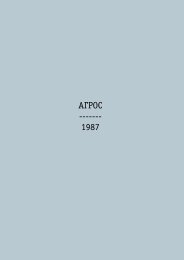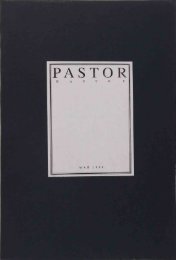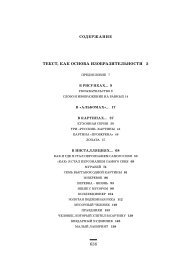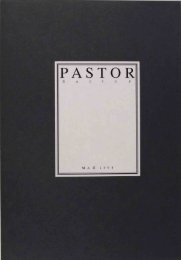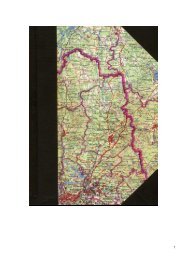А. Монастырский, Н. Панитков, И. Макаревич, Е. Елагина, С ...
А. Монастырский, Н. Панитков, И. Макаревич, Е. Елагина, С ...
А. Монастырский, Н. Панитков, И. Макаревич, Е. Елагина, С ...
You also want an ePaper? Increase the reach of your titles
YUMPU automatically turns print PDFs into web optimized ePapers that Google loves.
S.H.: In conclusion, let‘s turn to the last action, Slogan-2005. Unlike all the other pieces in CA‘s<br />
slogan series, this action removes the ―slogan-quality‖ of the slogan into the auditory sphere, if I am<br />
not mistaken. The initial phase of the action consisted in listening to a reading of the Diamond Sutra,<br />
playing on a tape recorder that suspended from a tree. The device of listening to an invisible voice is<br />
reminiscent of the form practiced by ancient religious cults, where the sphere of the invisible is<br />
associated with transcendental mystery. This tradition seems to shine through this slogan as a<br />
background. Then again, the action also gave rise to the state of listening as such, which supports the<br />
process of liberation from any concrete content that we were talking about before. This concentrates<br />
all attention on the perception of the material-formal details of the slogan as an installation in nature.<br />
One of the slogan‘s points of affixment 2 is marked by the fact that the tape recorder is fastened to the<br />
tree with yellow scotch tape. Another point of affixment is marked by an orange tumbler-doll.<br />
Between them, there are sheets of paper with scholarly commentary attached to the tree trunks. This<br />
obviously accentuates the design or the format of the slogan. And again, the text machine has been set<br />
into motion, producing text that branches out into various commentaries.<br />
I don‘t only think that that this can stimulate a one-way-movement that leads to more and more<br />
remote contexts that culminate in self-sufficiency. Instead, I imagine it as movement along a spiral<br />
that could unexpectedly lead to aesthetic contact with the surrounding context of the new Russian<br />
world.<br />
A.M.: I have no idea about contemporary contexts of Slogan-2005 and what‘s more, I find them<br />
completely uninteresting. Even if they are there, of course. For me, this slogan is, most importantly,<br />
an abstract composition, a chromatic structure. It is like a piece of music. It is somehow related to<br />
Daoist and Buddhist mentalities (and these might be quite contemporary and current, at least to CA).<br />
What seems very strange is the inclusion of living elements, such as a bound bundle of branches that<br />
took the place of the tape player, and the participation of a Pharaoh hound in the action‘s space. After<br />
the preceding four actions on the theme of Russian cosmism, this last action does not awaken any<br />
discursive desire to understand it at all. And that‘s a good thing.<br />
Translation: David Riff<br />
Sabine Hänsgen, Andrej Monastyrski<br />
Dialog über die Losungen der „Kollektiven Aktionen“<br />
S.H.: Die Bezeichnung der letzten Aktion „Losung 2005― verweist auf eine bestimmte Form des<br />
politischen Designs in der sowjetischen Kultur, aber auch auf eine Tradition von Performances<br />
innerhalb der Gruppe „Kollektive Aktionen―, bei denen Losungen verwendet wurden. Mir scheint es<br />
interessant, am Beispiel dieser Losungsaktionen noch einmal die Bedeutung der spezifischen<br />
Beziehungen zwischen äußeren und inneren Motivationskontexten für die Tätigkeit der Gruppe zu<br />
diskutieren.<br />
Ein wichtiges Sujetelement der „Reisen aus der Stadt―, die von den „Kollektiven Aktionen―<br />
organisiert werden, besteht in der Überschreitung einer Grenze. Der Übergang aus dem städtischen<br />
Raum in den ländlichen Raum ist dabei mit einer semiotischen Reduktion verbunden. Der ländliche<br />
Raum – das in einem metaphysischen Sinn leere Feld – wird zur Bühne für minimalistische<br />
Handlungen, die elementare raum-zeitliche Strukturen der Wahrnehmung thematisieren: Erscheinen<br />
– Verschwinden, Annäherung – Entfernung, Gehen, Stehen, Liegen, Klang – Stille, Pause,<br />
2 Trans. note: ―Point of affixment‖ is a specific term from the discourse of CA that may require some clarification.<br />
To Andrei Monastyrsky, the point of affixment, usually considered as a purely technical moment (i.e. a nail), has a<br />
central aesthetic value in defining the artwork‘s objectivity: it reveals the link of the artwork‘s material placement<br />
(on the ―expositional sign-field‖ of exterior reality and ideological motivations) to the immanent, conceptual logic of<br />
art. In other words, the ―point of affixment‖ supplies the artwork with its conceptual objectivity.




